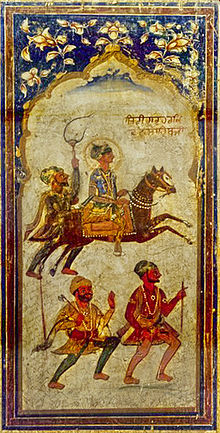Guru Har Krishan
Guru Har Krishan | |
|---|---|
 A fresco of Guru Har Krishan, ca. 1745 | |
| Personal | |
| Born | Har Krishan July 7, 1656[1] |
| Died | March 30, 1664 (aged 7)[1] |
| Cause of death | Smallpox |
| Religion | Sikhism |
| Spouse | none |
| Children | none |
| Parent(s) | Har Rai Mata Krishen |
| Other names | Bal Guru, The Eighth Master |
| Religious career | |
| Period in office | 1661–1664 |
| Predecessor | Har Rai |
| Successor | Tegh Bahadur |
| Part of a series on |
| Sikhism |
|---|
 |
Guru Har Krishan' ([ɡʊru həɾ kɾɪʃən]; 7 July 1656 – 30 March 1664[1]) was the eighth of the ten Sikh Gurus. At the age of 5, he became the youngest Guru in Sikhism on 7 October 1661,[1] succeeding his father, Guru Har Rai.[2] He contracted smallpox and died of the disease in 1664 before reaching his 8th birthday.[3]
He is also known as Bal Guru (Child Guru),[2] and sometimes spelled in Sikh literature as Hari Krishan Sahib.[3][4] He is remembered in the Sikh tradition for saying "Baba Bakale" before he died, which Sikhs interpreted to identify his granduncle Guru Tegh Bahadur as the next successor.[2][3] Guru Har Krishan Sahib had the shortest reign as Guru, lasting only 2 years, 5 months and 24 days.
Biography
Har Krishan was born in Kiratpur (Sivalik Hills) in northwest Indian subcontinent to Krishen Devi (Mata Sulakhni) and Guru Har Rai. His father, Guru Har Rai supported the moderate Sufi influenced Dara Shikoh instead of conservative Sunni influenced Aurangzeb as the two brothers entered into a war of succession to the Mughal Empire throne.[5] After Aurangzeb won the succession war in 1658, he summoned Guru Har Rai in 1660 to explain his support for the executed Dara Shikoh. Guru Har Rai sent his elder son Ram Rai to represent him. Aurangzeb kept the 13 year old Ram Rai as hostage, questioned Ram Rai about a verse in the Adi Granth – the holy text of Sikhs. Aurangzeb claimed that it disparaged the Muslims.[6][7] Ram Rai changed the verse to appease Aurangzeb instead of standing by the Sikh scripture, an act for which Guru Har Rai excommunicated his elder son, and nominated the younger Har Krishan to succeed as the next Guru of Sikhism.[6][8]
Aurangzeb meanwhile rewarded Ram Rai, patronizing him with land grants in Dehra Dun region of the Himalayas. A few years after Guru Har Krishan assumed the role of Sikh leader, Aurangzeb summoned the young Guru to his court, with an apparent plan to replace him with his elder brother Ram Rai as the Sikh Guru. However, Har Rai contracted smallpox when he arrived in Delhi and his meeting with Aurangzeb was cancelled. On his deathbed, Har Krishan said, "Baba Bakale", and died in 1664. The Sikh religious organization interpreted those words to mean that the next Guru is to be found in Bakale village, which they identified as Guru Tegh Bahadur, the ninth Guru of Sikhism.[5][3]
Authentic literature with more details about Guru Har Krishan's life and times are scarce and not well recorded.[9] Some of biographies about Guru Har Krishan, particularly about who his mother was, were written in the 18th century such as by Kesar Singh Chhibber, as well as in the 19th century, and these are highly inconsistent.[10]
Gallery
-
Gurudwara Bangla Sahib, where the Guru died
-
History of Gurudwara Panjokhra Sahib, Haryana
References
- ^ a b c d Mohindar Pal Kohli (1992). Guru Tegh Bahadur: Testimony of Conscience. Sahitya Akademi. pp. 12–13. ISBN 978-81-7201-234-2.
- ^ a b c HS Singha (2009), The Encyclopedia of Sikhism, Hemkunt Press, ISBN 978-8170103011, pages 96–97
- ^ a b c d Louis E. Fenech; W. H. McLeod (2014). Historical Dictionary of Sikhism. Rowman & Littlefield Publishers. p. 148. ISBN 978-1-4422-3601-1.
- ^ Pashaura Singh; Louis E. Fenech (2014). The Oxford Handbook of Sikh Studies. Oxford University Press. p. 951. ISBN 978-0-19-100412-4.
- ^ a b Arvind-Pal Singh Mandair (2013). Sikhism: the Guide for the Perplexed. Bloomsbury Academic. pp. 50–51. ISBN 978-1-4411-0231-7.
- ^ a b Har Rai: Sikh Guru, Encyclopedia Britannica (2015)
- ^ J. S. Grewal (1998). The Sikhs of the Punjab. Cambridge University Press. pp. 67–69. ISBN 978-0-521-63764-0.
- ^ William Owen Cole; Piara Singh Sambhi (1995). The Sikhs: Their Religious Beliefs and Practices. Sussex Academic Press. pp. 33–34. ISBN 978-1-898723-13-4.
- ^ Pashaura Singh; Louis E. Fenech (2014). The Oxford Handbook of Sikh Studies. Oxford University Press. p. 41. ISBN 978-0-19-969930-8.
- ^ Surjit Singh Gandhi (2007). History of Sikh Gurus Retold: 1606–1708 C.E. Atlantic Publishers. pp. 590–591 with note 2. ISBN 978-81-269-0858-5.



